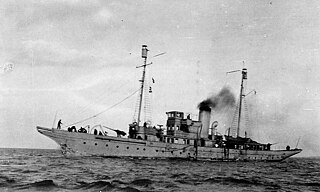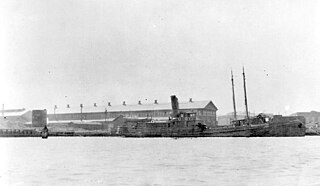
The second USS Conestoga (SP-1128/AT-54) was an ocean-going tug in the United States Navy. Commissioned in 1917, it disappeared in the Pacific Ocean in 1921. The fate of the vessel was a mystery until its wreck was positively identified in 2016.

USS Leonidas (AD-7) was a destroyer tender, the lone ship in her class, named for Leonidas I, and the second United States naval vessel to bear the name.

The auxiliary patrol vessel USS Yacona (SP-617) was built in 1898 in Scotland as a civilian steam yacht of the same name. Later, she was renamed Amélia as a survey yacht of the King of Portugal, before reverting to Yacona in 1901. She was acquired by the U.S. Navy in September 1917 and served until 1919 as a patrol vessel in the western Atlantic. In 1921 she was transferred to the Philippines as the governmental yacht Apo, serving until 1932.

USS Wadena (SP-158) was a converted yacht patrol vessel of the United States Navy during World War I. She was built in 1891 in Cleveland, Ohio, as a steam yacht for Jeptha Homer Wade II of Cleveland and New York City. During her Navy career, Wadena made several trips escorting submarine chasers across the Atlantic Ocean, and, later, patrolling in the Atlantic and Mediterranean. on 26 February 1918 Wadena came to the aid of sinking tug Mariner and rescued all of her crew.
USS SC-255, sometimes styled as either Submarine Chaser No. 255 or S.C.-255, was an SC-1-class submarine chaser built for the United States Navy during World War I. Like most members of her class, she was not named and known only by her designation.
USS SC-142, sometimes styled as either Submarine Chaser No. 142 or S.C.-142, was an SC-1-class submarine chaser built for the United States Navy during World War I. Upon completion, she was transferred to the French Navy

USS Lykens (SP-876/AT-56) was a steam tugboat purchased from the Reading Company by the United States Navy in 1917. Because she was privately built, she was not of a ship class. She was the only U.S. Navy ship of this name.

USS Mariner (SP-1136) was a wooden-hulled tugboat for the United States Navy in World War I. She had previously been the Jack T. Scully of the Neptune Line of New York before her acquisition by the Navy. She foundered and sank in a gale on 26 February 1918 while part of a convoy steaming to Bermuda.

The first USS Vedette (SP-163) was a commercial yacht built in 1899. At the outbreak of World War I, the yacht was leased by the United States Navy, and was used as a section patrol craft in the North Atlantic Ocean. She served honorably during the war, rescuing survivors at sea, and attacking a German U-boat. At war’s end, she was converted to her original configuration and returned to her owner, the railroad executive, financier, and philanthropist Frederick W. Vanderbilt (1856-1938) of New York City.

USS James (SP-429) — also known as USS W. T. James (SP-429) — was a steam trawler acquired by the United States Navy during World War I. She was converted into an armed minesweeper and assigned to the European Theater, where she performed varied tasks, including minesweeping, patrolling, and escorting of larger ships in convoy. In 1919, while returning to the United States, she was severely damaged in a storm off the French coast, and sank. Her crew were rescued.
The first USS Barnegat (SP-1232) was a commercial tugboat acquired by the U.S. Navy during World War I. She was armed with a 3-inch gun and sent to Brest, France, to perform towing services for Allied ships. Post-war, she returned to the United States, was decommissioned, and was subsequently used on the Delaware River by the U.S. Army Corps of Engineers.

USS Artemis (SP-593), launched as the steam yacht Cristina then upon sale the yacht was renamed Artemis. The yacht was purchased by the United States Navy during World War I and the name was retained. Artemis was armed with guns and depth charges and sent to Europe as a patrol craft to protect Allied ships from German submarines and other dangers. The patrol yacht was renamed Arcturus in 1918. Post-war she was returned to the United States and turned over to the United States Coast and Geodetic Survey. Later, again Artemis, the vessel was in civilian operation until burning and sinking in 1927.

USS Concord (SP-773), later known as USS Mendota (YT-33) and again later as USS Muscotah (YT-33) was a tugboat acquired by the U.S. Navy during World War I. Concord was initially assigned to North Atlantic towing duties, and later was assigned as harbor tug at the Washington Navy Yard. She was sold in 1937.

USS Margaret (SP-527) was a yacht acquired by the U.S. Navy during World War I and in commission as a patrol vessel from 1917 to 1918. She was assigned to escort and patrol duty in the North Atlantic Ocean. Unfortunately, she had numerous mechanical problems and her commanding officer -- Lieutenant Commander Frank Jack Fletcher (1885–1973), a future admiral and aircraft carrier task force commander of World War II – did not consider her an effective fighting ship. Fletcher would finally ask the Navy to condemn her as unfit for naval service—something the Navy promptly did.

USS Goliah (SP-1494), also listed as ID-1494, was an armed tug that served in the United States Navy as a patrol vessel and tug from 1918 to 1919.

USS East Hampton (SP-556) was a United States Navy minesweeper, patrol vessel, and lightvessel in commission from 1917 to 1919.

USS Aramis (SP-418/PY-7) was a yacht acquired by the United States Navy during World War I which served as a patrol boat off New York City, was then fitted with an experimental "underwater detection system" and depth charges as an anti-submarine vessel, and was briefly the flagship of a battleship squadron. She ended her career as a tender and houseboat to a survey vessel off the coast of Cuba, until disposed of in 1933.

USS Dreadnaught (ID-1951), later YT-534 and YNG-21, was a United States Navy tug that was in service from 1918 to 1944.

USS Sea Rover (SP-1014), later AT-57, was a United States Navy armed tug in commission from 1918 to 1921.
USS SC-95, prior to July 1920 known as USS Submarine Chaser No. 95 or USS S.C. 95, was an SC-1-class submarine chaser built for the United States Navy during World War I. She operated as part of the Otranto Barrage during the war. Postwar, she saw service in the Adriatic Sea, in North Russia, and in the clearance of the North Sea Mine Barrage. After her U.S. Navy service, she became a private motor yacht.
















